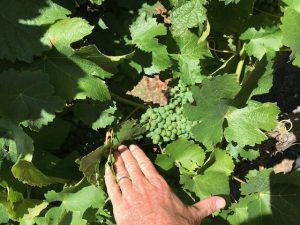While Rob waits patiently for our Pinot Noir to ripen just enough to pick for our Sparkling, let’s take a closer look at some of your questions about one of our most popular and “Trophy-winning” (have I mentioned that before?!) wines.
What’s all the kerfuffle about using the word “Champagne”?
Although sparkling wines are produced around the world, legally the word Champagne is reserved exclusively for sparkling wines from the Champagne region in France and made in accordance with regulations governed by the Comité Interprofessionnel du vin de Champagne (CIVC) and protected under a treaty (so, I guess they’re pretty serious about it!).
For champagne to be champagne, the grapes need to be sourced from specific parcels in the Champagne appellation (which is short for a long fancy French term which means “protected designation of origin”) using specific vineyard practices, pressed using regimes unique to the region and made using secondary fermentation of the wine in bottle to create the bubbles (read on for more information on how this is done).
What is involved in making Sparkling using the traditional method?
The traditional method of making Sparkling wine involves a number of steps…
- The grapes are pressed and go through a primary fermentation like any other table wine. It is then bottled.
- A second fermentation is induced by adding more yeast and sugar (usually in the form of grape juice). A crown seal (like a beer bottle) is added to the bottle and the fermentation occurs in the bottles, which creates the bubbles.
- The wine is then left to sit on yeast lees. In Champagne, the minimum amount of time specified by the appellation is 1.5 years. This is also the minimum amount for Rob, but he usually leaves it to mature for much longer than this.
- After aging, a process called remuage (or “riddling” in English) is performed either manually or mechanically, to gradually invert the bottle and settle the lees into the neck.
- The neck of the bottle is frozen, whereupon the lees freeze to a sold block, and the crown seal is removed. The pressure in the bottle forces the frozen lees out of the bottle. The wine is then topped up with additional wine (le dosage) and quickly corked (or another crown seal added) to maintain the bubbles. The dosage is not only designed to replace the volume lost during the disgorging process, but gives the winemaker a change to adjust the sweetness of the wine. For Rob, the dosage he uses is much drier that most.
Is there any other way to make Sparkling wine?
A large proportion of Australian Sparkling wine is not made using this time consuming and expensive method. There are others ways to make Sparkling wine, including adding a gas under pressure to the wine to add the bubbles… just like how your soda stream works at home. But we don’t recommend using your soda stream to add bubbles to your wine!
Why does Rob use a crown seal instead of a cork?
Well, firstly, he’s terrified someone will take an eye our with a cork! Secondly, with a crown seal there is very little chance that any gas can escape the bottle, meaning you can hang onto a bottle of Somerled Sparkling for years and it will be just as bubbly as it is today. Given the porous nature of cork, it is inevitable that some of those bubbles will disappear over time.
How do you make a Sparkling white wine out of a red grape variety?
If you bite into a red grape, what colour is the flesh usually? Most red grapes have white flesh. In fact, there are very few varieties of red grapes in the world which have red flesh (Alicante is one of them). Actually, the only thing the contributes to the colour of a red wine is its skin.
So, if you press the grapes ever so carefully and remove immediately separate the juice form the skins then you can make a white wine!
Traditionally, Sparkling wine is made from Pinot Noir, Pinot Meunier and Chardonnay.
Do you have any other Sparkling related questions for us? We’d love to see your questions and thoughts in the comments section below.
How about this weather??
At least the rain is good for the garden… but what about the grapes?
To be perfectly honest, it’s not ideal. Refer back to last week’s post for our discussion on powdery mildew (did I jinx it?!). And tune in next week to find out what exactly what effect this weather will have. In the meantime, send good thoughts to the wine Gods!
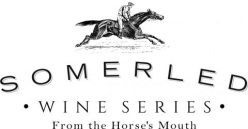
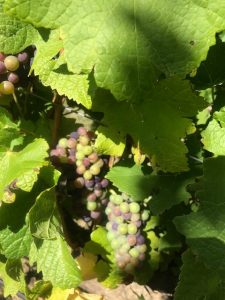 That said, there is still plenty happening…
That said, there is still plenty happening…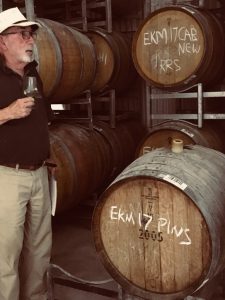 So, a couple of weeks ago you would have read that the
So, a couple of weeks ago you would have read that the 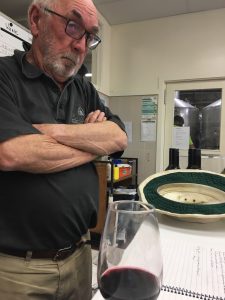 This is a photo of a very serious looking Rob in the winery last week trying to decide which fining agent to use on the Shiraz. The quantity and type of agent used can cause subtle changes in the structure and taste of a wine. Although Rob adores the 15 Shiraz as is, he did wonder if it needed a little softening on the tannins. So, in the lab, he compared samples using 50 parts per million (ppm) of gelatin, 100 ppm gelatin and one using PVPP against the standard to come up with the right one for the job. The sample using 100 ppm gelatin was the winner – the tannins were softened nicely and the middle palate became a lot rounder and softer, without damaging any other characters of the wine.
This is a photo of a very serious looking Rob in the winery last week trying to decide which fining agent to use on the Shiraz. The quantity and type of agent used can cause subtle changes in the structure and taste of a wine. Although Rob adores the 15 Shiraz as is, he did wonder if it needed a little softening on the tannins. So, in the lab, he compared samples using 50 parts per million (ppm) of gelatin, 100 ppm gelatin and one using PVPP against the standard to come up with the right one for the job. The sample using 100 ppm gelatin was the winner – the tannins were softened nicely and the middle palate became a lot rounder and softer, without damaging any other characters of the wine.